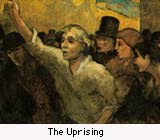|
.
Dali, Salvador 1904-1989 Spanish surrealist painter 'The Persistence of Memory', painted in 1931, is perhaps the most widely recognized surrealist painting in the world . Dali was influenced by Freud's theory of the unconscious, and in Paris he joined a group of artists - called the Surrealists. Dali's artistic style crypstallized into a blend of precise realism and dreamlike fantasy that became his hallmark. He showed people and objects transformed into fantastic photographic-like images that are often set in deserted landscapes. During World War II Dali and his wife, Gala, took refuge in the United States, returning after the war's end to Spain. His reputation was based as much on his flamboyance and flair for publicity as on his prodigious output of paintings, graphic works, and book illustrations. Despite all that has been written by and about him, Dali remains an enigma as a man and as an artist. In collaboration with Bunuel Dali also produced two films, filled with grotesque images: 'An Andalusian Dog' and `The Golden Age'.
www link :
The Parisian public admired Daumier as the newspaper caricaturist who so perceptively skewered their daily lives, but they never accepted him as a painter. Daumier died blind and a pauper without ever having received a painting commission. He was imprisoned for six months for a caricature he drew of King Louis Philippe in the weekly journal La Caricature in 1832. After the state suppressed La Caricature, Daumier turned to social satire. He ridiculed the bourgeoisie and the legal system and unsentimentally showed the misery of the masses with his crayon, much as Charles Dickens observed London in words. His painting 'Don Quixote', and his series of satirical lithographs are the best known of his works. He produced about 3950 lithographs and some 200 paintings.
www link :
After studies at the Academie Royale David won the coveted Prix de Rome. Visits to ruins and exposure to Neoclassical doctrines encouraged him to adopt a style and subject matter derived from antiquity Returning to Paris, David soon prospered. Large canvases of classical themes brought him a sensational success at the Paris Salon in 1785. His style was sculptural and servere with firm linear contours. The paintings came to be regarded as a political manifesto for ending the corruption of the aristocracy and returning to the stern, patriotic morals attributed to republican Rome. His painting 'The Oath of the Horatii', greatly aroused revolutionary feelings in France. Under Napoleon he painted the great events of Emperor's life.
www link :
|


